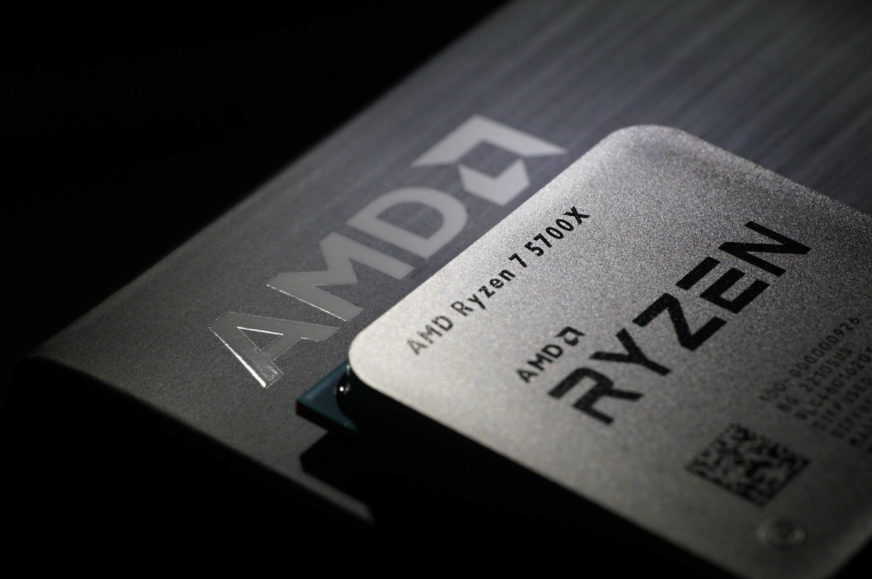AMD Ryzen 7 5700X in detail
At the eleventh hour, but still. The long-awaited Ryzen 7 5700X is here. However, we won’t be writing about the successor to the Ryzen 7 3700X as a significantly cheaper alternative to the Ryzen 7 5800X. The new octa-core Ryzen 7 5700X is primarily more economical compared to the higher-end model. Its power draw is just half in some tasks, which means that temperatures are also significantly lower.
Conclusion
Finally, AMD has an 8-core processor, which shows just how efficient the Zen 3 architecture is, as long as frequencies aren’t pushed too far. While the Ryzen 5800X is the least efficient Vermeer, the 5700X is one of the most efficient. In a massive multithreaded workload, this processor’s efficiency is even on par with the Ryzen 9 5950X.
With eight cores, the Ryzen 7 5700X may not be among the top of the line, but it is still an attractive compromise that can be well suited to a gaming rig that is expected to deliver higher multi-threaded performance. But first, then, those games. The Ryzen 7 5700X doesn’t fall more than 8 % behind the more aggressively clocked R7 5800X on average, and even that’s at an extremely low, essentially synthetic 720p resolution. In the more practical 1080p and 1440p, it’s already within 5 %. And even that small difference is often rather smaller. The average gap is widened significantly on the 5700X in particular, by the 26–28 % slower Counter-Strike: GO. There is also a big performance difference in favour of the R7 5800X in DOOM Eternal (8–11%), in F1 2020 or in Microsoft Flight Simulator (up to 8 % in FHD), but in many titles the Ryzen 7 5700X falls behind by virtually nothing. Whether it’s Metro Exodus, Shadow of the Tomb Raider, Assassin’s Creed: Valhalla or even Total War Saga: Troy, in which differences in CPU performance tend to show up. The thread count matters more than the frequency in TWST.
The gaming performance of the R7 5700X is slightly lower compared to the R7 5800X, but due to the significantly lower power draw (up to 28 % in games) the performance per watt is higher. And quite significantly. But we will come back to power draw. So for now, just briefly, so that we have a closed chapter around the operation in games.
In the PCMark subtests, it’s easy to see which applications are single-threaded and which make more intensive use of multiple cores. In the single-threaded ones, the differences are minimal, as the Ryzen 7 5700X is only symbolically slower here. Bigger, but still relatively small, differences are during app initialization, photo editing (PCMark tests this in the free Gimp) or during 3D rendering. On the web, apart from more demanding tasks such as virtualization, compilation or working with strings and arrays, the performance difference is also indistinguishable. The 500 MHz difference, by which the Ryzen 7 5700X is slower, is between 10-12 % in a “hard” multi-threaded workload. Typically 3D rendering, video encoding with x264/265 or AV1 encoders will fit into this interval. For video editing, the difference between the R7 5700X and R7 5800X is often already under 10 %, unless it’s just live 4K AVC video playback in Adobe Premiere Pro, where the Ryzen 7 5700X achieves significantly lower fps due to the lower frequencies. This is because it is neither a single-threaded load nor does it engage all eight cores. This is typically the situation where the R7 5700X can fall furthest behind the R7 5800X.
When it comes to bulk photo editing, the performance difference is often only 5 % to the detriment of the Ryzen 7 5700X. The processor is loaded to the max here, across all threads, but the frequency doesn’t matter that much. Similarly, neither when (de)compressing. For (de)encryption the difference is again around 12 %. And then there are pure single-threaded tests where the performance of the R7 5700X is like that of the R5 5600X. Although it is usually a hair higher. Really only negligibly, and we point this out only to highlight the more stable boost. It drops here and there on the R5 5600X. The average of all samples is therefore 10 MHz lower than on the R7 5700X, with which it holds without faltering at 4650 MHz.
Best for last – low power draw and high efficiency. The 50 % reduction over the R7 5800X applies to peak workloads, such as rendering. Naturally, with a lower load, the difference in power draw is reduced, but it’s still high, always above 20 % in games. Instead of 91W (R7 5800X), the R7 5700X in Total War Saga: Troy is down to 66 W (at higher resolutions like FHD, and lower, it’s even a bit less). The Ryzen 7 5700X is always significantly more efficient or delivers more performance per unit of power. That’s even in a single-threaded workloads. And that’s even compared to the R5 5600X, for example, where we’ve praised the efficiency and that doesn’t change. Except the R7 5700X is still some 14 % (5W) below that processor. The R7 5700X is a hair more efficient (compared to the R5 5600X) even in idle mode.
Nice to see are the temperature results as well. When comparing the maximum performance, the difference between the R7 5800X and R7 5700X is almost 30°C. In games, it’s proportionally less again, but it’s still pretty much the same as in single-threaded workloads. There, the Ryzen 7 5800X, with a weaker cooler, can already get to throttling temperatures, which is not the case with the Ryzen 7 5700X.
English translation and edit by Jozef Dudáš
| AMD Ryzen 7 5700X |
| + High-end single-thread performance |
| + Perfect efficiency or performance per unit of power draw |
| + Significantly more efficient than Ryzen 7 5800X |
| + Attractive price-to-multi-threaded performance ratio |
| + "Universal" processor for faster computing and gaming at an affordable price |
| + High performance per clock (IPC) |
| + Low temperatures with a decent headroom for PBO2 or manual overclocking |
| + Modern 7nm manufacturing process |
| - Slightly worse price/performance ratio than the Ryzen 7 5800X |
| - Does not have an integrated graphics core |
| Approximate retail price: 300 EUR |
Games for testing are from Jama levova
Special thanks to Blackmagic Design (for a DaVinci Resolve Studio license), Topaz Labs (for licenses for DeNoise AI, Gigapixel AI and Sharpen AI) and Zoner (for Photo Studio X license)
- Contents
- AMD Ryzen 7 5700X in detail
- Methodology: performance tests
- Methodology: how we measure power draw
- Methodology: temperature and clock speed tests
- Test setup
- 3DMark
- Assassin’s Creed: Valhalla
- Borderlands 3
- Counter-Strike: GO
- Cyberpunk 2077
- DOOM Eternal
- F1 2020
- Metro Exodus
- Microsoft Flight Simulator
- Shadow of the Tomb Raider
- Total War Saga: Troy
- Overall gaming performance
- Gaming performance per euro
- PCMark and Geekbench
- Web performance
- 3D rendering: Cinebench, Blender, ...
- Video 1/2: Adobe Premiere Pro
- Video 2/2: DaVinci Resolve Studio
- Graphics effects: Adobe After Effects
- Video encoding
- Audio encoding
- Broadcasting (OBS and Xsplit)
- Photos 1/2: Adobe Photoshop and Lightroom
- Photos 2/2: Affinity Photo, Topaz Labs AI Apps, ZPS X, ...
- (De)compression
- (De)cryption
- Numerical computing
- Simulations
- Memory and cache tests
- Processor power draw curve
- Average processor power draw
- Performance per watt
- Achieved CPU clock speed
- CPU temperature
- Conclusion











Nice review, especially the details in the Premiere Pro part.
However, there are some questionable results, namely the “4K H.264, 2× Forward Live Playback [avg. fps] – higher is better” and others, where the 5700X is last by a wide margin. Have you redone the tests (or ran similar tests) to see if this was just an outlier? It would have been nice to at least have a comment on such a weird result…
Thanks for your comment. The explanation is in the text of the final chapter, and I also explain this behavior in the Ryzen 5 5600 test, which performs better, but is still the second processor from the bottom in the charts. The point is that 4K H264 live playback is a single-threaded task in Premiere Pro, but because of the utilization of the other cores by other application processes, the frequencies are only at the all-core boost level. These are pretty conservative for the Ryzen 7 5700X from today’s perspective (the 5600 is 300 MHz faster here, hence the higher fps), plus Zen 3 doesn’t handle 4K H.264 well overall, and better results are achieved with both 4K ProRes 222 and 4K RED.
Thanks for replying. I read the explanation at the end of the review, but “the 500 MHz difference” still didn’t seem to be enough of a reason for such a big difference. Something else must be at play here, though I am also not sure of what it may be.
why in total war troy 5600x shows more fps than 5700x? after all, this strategy loads the processor well and, according to the logic, the 16th nuclear one should have come out with a large margin from the 12th nuclear one !! ps: I myself am a fan of total war warhammer 1/2/3 and have a 5600x processor, but yesterday I ordered a new 5700x processor
The reason for this is apparently very simple. The 6 cores/12 threads of the R5 5600X processor do not represent a bottleneck for TWST, and higher clock speeds are decisive for higher performance. And those the R7 5700X achieves are lower.
Great review, really liking the detailed analysis. I saw a comment on reddit that linked to this review stating that if the 5800x was limited to 65w TDP, the performance efficiency might be similar to the 5700x. Have you thought about testing this out?
Thanks for your comment. Due to a lot of time pressure, we probably won’t be testing the R7 5800X with reduced power draw anymore. But if we see a similar situation with the Ryzen 7000 and something like the R7 6700(X) and R7 6800, we’ll definitely take a look at it. However, it’s good to note that such analyses require multiple CPU samples to operate outside of their specs. The fact that a single 5800X sample would be limited to 65W and the performance was higher than the R7 5700X@TDP/65W doesn’t mean anything relevant yet.
It’s similar to overclocking. Based on one sample, it is not possible to generalize that this or that frequency will be achieved at xyz W of power draw. You always have to evaluate it based on multiple samples of processors and sooner or later we will get to that and once we have more of them (those test samples) we will for sure look at the variance of the measured values across the samples as well.